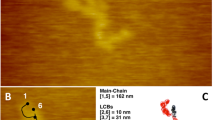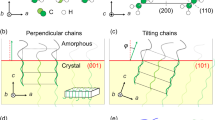Abstract
PERPENDICULAR orientation (chain-molecules perpendicular to an axis of rotation) has been frequently reported in studies on polyethylene. I have shown1 that very similar X-ray patterns can be given by two entirely different perpendicular structures: (i) where the a-axis is parallel to the fibre-axis and consequently b and c are perpendicular to it; (ii) where the b-axis is an axis of cylindrical symmetry, and the b-axes themselves are randomly arranged in planes perpendicular to the direction of draw, which itself is perpendicular to the X-ray beam.
This is a preview of subscription content, access via your institution
Access options
Subscribe to this journal
Receive 51 print issues and online access
$199.00 per year
only $3.90 per issue
Buy this article
- Purchase on Springer Link
- Instant access to full article PDF
Prices may be subject to local taxes which are calculated during checkout
Similar content being viewed by others
References
Keller, A., J. Polymer Sci. (in the press).
Holmes, D. R., Miller, R. G., Palmer, R. P., and Bunn, C. W., Nature, 171, 1104 (1953).
Author information
Authors and Affiliations
Rights and permissions
About this article
Cite this article
KELLER, A. Perpendicular Orientations in Polyethylene. Nature 174, 926–927 (1954). https://doi.org/10.1038/174926a0
Issue Date:
DOI: https://doi.org/10.1038/174926a0
This article is cited by
-
Röntgenographische Bestimmung unterschiedlicher Kristallitorientierungen in Polyäthylen-Spritzgußteilen
Kolloid-Zeitschrift und Zeitschrift für Polymere (1972)
Comments
By submitting a comment you agree to abide by our Terms and Community Guidelines. If you find something abusive or that does not comply with our terms or guidelines please flag it as inappropriate.



